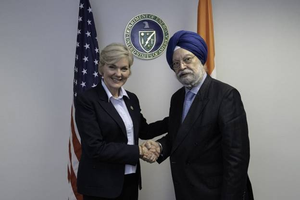Add your promotional text...
India and the U.S. Strengthen Partnership to Drive Clean Energy Innovation
Synopsis: India and the United States are advancing their strategic partnership to accelerate clean energy transitions and enhance energy security. Through the Strategic Clean Energy Partnership (SCEP), the two nations are focusing on renewable energy, emerging technologies, grid modernization, and decarbonization efforts, including joint initiatives on hydrogen safety, energy storage, and electric vehicle deployment. The collaboration underscores their shared commitment to addressing global climate challenges.
TOP STORIES
By Vishwash Saxena
9/17/20242 min read


India and the United States are making remarkable strides in fostering energy innovation, bolstering energy security, and advancing clean energy transitions. These efforts are also focused on clean energy manufacturing and creating resilient, secure, and diversified supply chains. This progress was announced during the Strategic Clean Energy Partnership (SCEP) ministerial meeting, held in Washington, DC, under the leadership of U.S. Energy Secretary Jennifer Granholm and India’s Petroleum and Natural Gas Minister Hardeep Singh Puri.
The SCEP ministerial reviewed various initiatives that span technical pillars such as energy efficiency, responsible oil and gas, renewable energy, emerging technologies, and sustainable development. The discussion highlighted the critical role of energy trade in aligning with the national priorities of both nations.
Both countries acknowledged the significant headway made in accelerating the development and deployment of emerging clean energy technologies. Key areas of progress include enhancing renewable energy deployment, improving grid reliability and integration, promoting energy efficiency, and driving decarbonization in high-emission sectors like industry, buildings, and transportation.
A key highlight of the meeting was the official launch of the Renewable Energy Technology Action Platform (RETAP), which took place in August of last year. RETAP focuses on developing roadmaps for hydrogen, long-duration energy storage, offshore wind, and geothermal energy through research, pilots, and industrial partnerships.
The U.S. and India also celebrated collaboration on the National Centre for Hydrogen Safety in India and the success of the second International Conference on Green Hydrogen, which took place this month. Furthermore, both sides stressed the importance of integrating renewable energy into the grid while ensuring grid flexibility and reliability through energy storage solutions.
Modernizing the power distribution sector to ensure 24/7 reliable energy for consumers was another key focus. This included India’s initiatives in smart metering deployment, power market reforms, cybersecurity, and energy system resilience. The efforts of Indian Railways to achieve net-zero emissions by 2030 were also recognized, with both countries welcoming collaboration on renewable energy procurement and the development of an energy efficiency action plan for railway facilities.
The two nations also discussed joint efforts to electrify medium and heavy-duty vehicles and applauded the PM eBus Sewa initiative, aimed at deploying 10,000 electric buses across India. Both sides reaffirmed their commitment to deepening the U.S.-India partnership to advance clean energy goals and tackle global climate challenges.,
